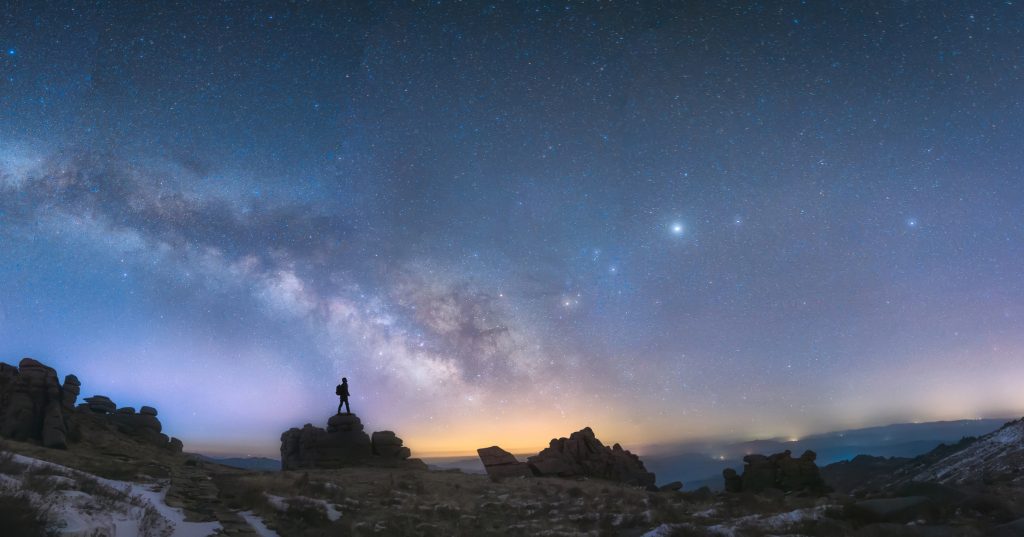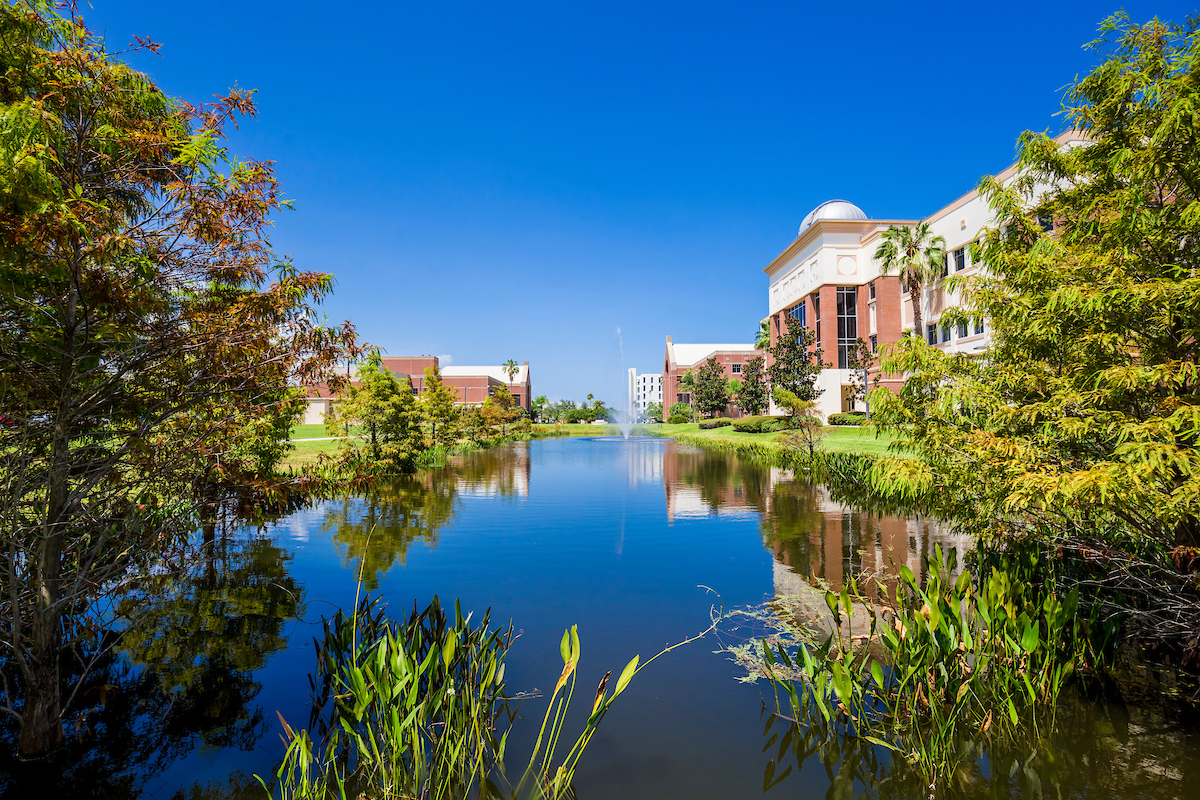Florida Tech Research Year in Review, Part 1
As we wrap up 2021, here are some university research highlights from this year.
Oceanography assistant professor Kelli Hunsucker’s work with organism growth is two-fold. Her biofouling research analyzes new ways to keep organisms from accumulating on ship hulls and corroding them. However, it’s the other side of her work with these same organisms that may have some positive impacts on the water quality of the Indian River Lagoon.
Since 2016, Hunsucker, alongside ocean engineering associate professor Robert Weaver and Florida Tech’s Indian River Lagoon research team, has partnered with the local community through the Living Docks program. The program involves wrapping dock pilings with oyster mats. The idea is that the mats facilitate the growth of oysters, barnacles and sponges, all of which are filter feeders that help remove excess nitrogen from waters by incorporating it into their shells and tissue as they grow.
“Someone once told me, it’s only a weed if you don’t want it,” Hunsucker said. “That’s kind of the approach I use for my yard and that’s the approach we use for the Living Docks. Most people think of barnacles, tubeworms and sea squirts as biofouling, things that we typically don’t want, but when you think about their ecosystem benefits, they provide a good service such as water filtration, habitat structure, and a food source.” For more, click here.
Key atmospheric electricity studies that may give researchers a better understanding of the implications for lightning safety and protection of missions and assets were recently conducted at Kennedy Space Center (KSC).
Aerospace, Physics and Space Sciences associate professor Amitabh Nag, along with research professor Kenneth Cummins, graduate student Mathieu Plaisir, Distinguished University Professor Hamid Rassoul and researchers from KSC, recently published the paper, “Inferences on Upward Leader Characteristics from Measured Currents” in Atmospheric Research.
Lightning coming down from a stormy sky and striking ground or grounded objects can be a common sight in places like Florida. Just before lightning attaches to a grounded object, a set of “attachment processes” occur. These include the creation of one or more upward moving lightning leaders or plasma channels (usually carrying positive charge) from ground or grounded objects near the downward progressing lightning leader (usually carrying negative charge). A lightning strike to ground occurs when one of these positively charged plasma channels collides with the downward moving negative plasma channel via a process called the “breakthrough phase.” Improved understanding these processes and the detailed nature of natural lightning currents and electromagnetic fields are key goals of this project, which is funded by the National Science Foundation and the U.S Air Force. For more, click here.

Toufiq Reza has conducted plenty of research in his role as assistant professor of chemical engineering, but a recent grant is allowing him to potentially improve the lives of millions of residents in his native country of Bangladesh.
Reza and researchers from Bangladesh University of Engineering and Technology, Bangladesh Agriculture University and Dhaka University recently received a three-year international grant worth $174,000 from the National Academy of Sciences and the United States Agency for International Development (USAID) that will allow them to examine the use of biogenic residue in Bangladesh to create clean energy, such as hydrogen production.
As one of the fastest-growing countries in South Asia, Bangladesh is expected to experience a rise in energy demand. However, fossil fuel reserves in the country of 180 million people have already been depleted. But researchers may be able to find a silver lining to that energy consumption: a byproduct called biogenic waste, which is an organic material that degrades with time, polluting the environment.
The team is researching how to convert biogenic waste into energy that could then be distributed inexpensively across the country via low-risk, accessible, modular hydrogen generation systems. The project proposes an innovative process that uses biogenic residues for renewable hydrogen generation on the modular scale. Anaerobic co-digestion, biogas cleaning, and management of digestate, which is the material remaining after the anaerobic digestion of a biodegradable feedstock, will address current operations and maintenance issues and waste management limitations of ongoing biogas programs in the country.
“I was raised in Dhaka, Bangladesh, one of the most densely populated cities in the world. We were accustomed to scheduled blackouts every day due to the lack of electricity generation compared to the electricity demand,” Reza said. “With the natural gas deleting out gradually and not much land to dedicate for energy production, I was concerned about the future of energy sector in Bangladesh. By knowing that more people mean more waste, I was always keen to find a way to convert waste to energy.” For more, click here.
A patent involving Florida Tech faculty may protect growing computer networks with ever-growing cybersecurity threats.
Marco Carvalho, Florida Tech executive vice president and provost, and computer engineering and sciences associate professor Thomas Eskridge, working in collaboration with engineers from Raytheon BBN Technology Corp., have developed a “decision engine” to configure the best set of defenses to combat threats against a system. The engine uses a genetic algorithm to search through several possible defense configurations and has an interface where users can interact and provide feedback on the direction and characteristics of the evolved solutions. The patent was awarded December 2020. The team also developed a patent-pending user interface that allows the operator to direct the genetic algorithm.
By using a genetic algorithm, the system can decide where to place defenses on the network based on the user’s preferences, allowing for stronger and more efficient protection than seen in previous systems. Eskridge noted the team tested the application by using over 100 possible placements and configurations of defenses, with a set of criteria that evaluates how well they perform. The results led to successful deployments via the algorithm’s adaptability in providing defense against attacks.
“I know what a good defense system will do for me: It will block these bad things, it will let my traffic through, it will keep privacy on this particular link at a very high level. It will do all these things. I just don’t know how to configure it to do it,” Eskridge said. “So, the algorithm figures out if a particular configuration is what you’re looking for and provides the best way to get what you want for as little cost as possible.” For more info, click here.

One of the fundamental themes in astrobiology is to seek to ascertain the origin and distribution of life in the cosmos. As part of this, the field also deals with how life may be transferred from one planetary system to another. Recent research may give insight into how we could detect traces of this intriguing process in the future.
Florida Tech assistant professor of astrobiology Manasvi Lingam, along with researchers from Ecole Polytechnique Federale de Lausanne in Switzerland and University of Rome in Italy, recently completed the paper, “Feasibility of Detecting Interstellar Panspermia in Astrophysical Environments,” which has been accepted for publication in The Astronomical Journal.
The research analyzes the process of how planets are bombarded by rocks, and how life-carrying microbes that may be on those rocks spread from one planet to bring life to another one. Life on planets might have been initiated by panspermia, a millennia-old theory that microbes living amid space dust, comets and asteroids are transferred to the planet as these objects collide with its surface. In their paper, Lingam and his team present a sophisticated mathematical model that factors in how long microbes survive, the rates at which the particles disperse, and the velocities of ejecta – the material forced out as a result of impact – to assess the prospects for detecting interstellar panspermia.
The paper shows that the correlations between pairs of life-bearing planetary systems may serve as an effective diagnostic of interstellar panspermia, provided that the velocity of the microbe-bearing ejecta is greater than relative velocities of stars. The team generated hands-on estimates of the model parameters for various astrophysical environments and concluded that open clusters and globular clusters (i.e., tightly clustered environments) appear to represent the best targets for assessing the viability of interstellar panspermia. For more, click here.
Naturally occurring lightning in the Earth’s atmosphere releases tremendous amounts of energy in a very short time. Some researchers believe it was a potential catalyst in the start of life on Earth.
University researcher Jeremy Riousset is examining lightning on Mars and its potential role in being a catalyst for life on the planet.
Jeremy Riousset, assistant professor of planetary sciences, started the project, “CAREER: Atmospheric Electricity on Earth and Mars,” on May 1. It is a five-year endeavor that will involve studying the physics and observability of electrical discharges in atmospheric conditions representative of Earth and Mars, with a goal of furthering our understanding of the physics of electrical discharge in diverse environments.
“Is there or has there been lightning on Mars? That is the question,” Riousset said. “Lightning can destroy life, as we know; a lightning strike can cause damage. Lightning can also be a trigger for life.”
The research looks to answer three key questions about planetary electricity: Can geometric factors adequately explain the difference between theoretical and observed lightning initiation thresholds? Can modeling help assess the nature of atmospheric breakdown occurring in the form of upper atmospheric lightning or putative Martian lightning? And can tribocharging – the contact electrification process that enables buildup of static electricity due to touching or rubbing of surfaces in specific combinations of two different materials – lead to the initiation of non-conventional discharges? For more info, click here.





